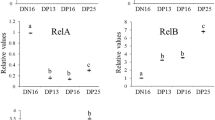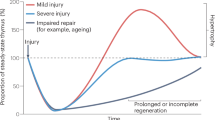Abstract
Intrauterine and early postnatal malnutrition caused a marked and protracted weight reduction of the body, spleen, and thymus. The mean body weight of the offspring of the malnourished mothers at weaning was 25 ± 10 g whereas that of the controls was 75 ± 20 g. At weaning the mean spleen weight of the malnourished offspring was 0.19 ± 0.05 g and that of their controls was 0.4 ± 0.13 g. During refeeding the spleen weight but not the thymus weight of the malnourished offspring caught up with that of the controls after about 70 days. After refeeding for as long as 4 months the thymus weight of the malnourished was still significantly (P < 0.01) less than that of the corresponding weight-matched controls. Primary and secondary plaque-forming cells (PFC) in both the spleen and thymus of the weanling malnourished offspring were barely detectable whereas spleen of their controls had mean approximate values of 50 × 103 primary PFC and 70 × 103 secondary PFC. The corre-sponding values in the control thymus were 20 × 102 primary PFC and 8 × 102 secondary PFC.
After refeeding for 4 months of the weanling malnourished offspring their primary and secondary PFC in the spleen increased to about one-half the level of that in their controls whereas the PFC in the thymus were still barely detectable. On the other hand, mean primary and secondary rosette-forming cells (RFC) in the spleen of the weanling malnourished offspring were less than 1 × 103 in comparison to the 80-90 × 103 in the controls (P < 0.001). In the thymus too, mean primary and secondary RFC were also less than 1 × 103, whereas the corresponding figure in the controls was 30-50 × 103 RFC. After refeeding for 4 months the mean values of both the primary and secondary RFC in the spleen and thymus continued to remain less than 1 × 103.
Although cell morphology in the spleen of the malnourished offspring had returned to normal appearance after 4 months of refeeding, that of the corresponding thymus had not done so completely. For instance, thymic corticomedullary function had reappeared by this time but thymocytes were still less in number than in the controls. By the 8th postnatal day serum IgG2b allotype became detectable in the control offspring, but it was not until day 20 that this IgG allotype could be detected in the malnourished offspring. IgG2a allotype could be detected in the sera of both the malnourished and control offspring.
Speculation: Impairment of cell-mediated immune response caused by intrauterine and neonatal protein-calorie malnutrition is probably responsible for the skin, oral, and respiratory tract infections seen in children with early protein-calorie malnutrition. Thymic reconstitution might play a significant role in the treatment of these children. This speculation is now being investigated.
Similar content being viewed by others
Log in or create a free account to read this content
Gain free access to this article, as well as selected content from this journal and more on nature.com
or
Author information
Authors and Affiliations
Rights and permissions
About this article
Cite this article
Olusi, S., Mcfarlane, H. Effects of Early Protein-Calorie Malnutrition on the Immune Response. Pediatr Res 10, 707–712 (1976). https://doi.org/10.1203/00006450-197608000-00001
Issue date:
DOI: https://doi.org/10.1203/00006450-197608000-00001
Keywords
This article is cited by
-
In Vivo Implications of Potential Probiotic Lactobacillus reuteri LR6 on the Gut and Immunological Parameters as an Adjuvant Against Protein Energy Malnutrition
Probiotics and Antimicrobial Proteins (2020)
-
Nutritional modulation of phagocyte function with special emphasis on the newborn
The Indian Journal of Pediatrics (1990)



